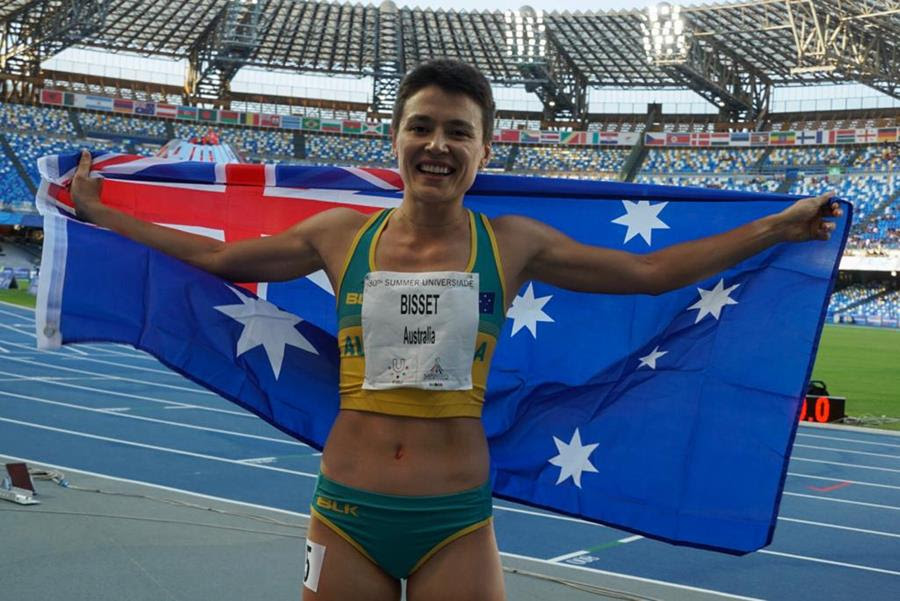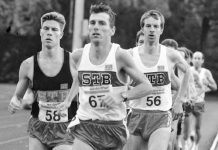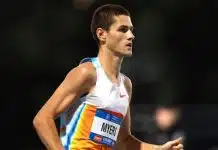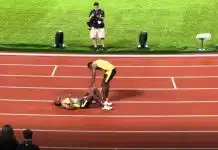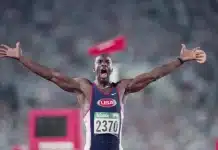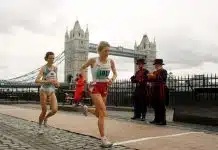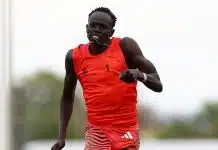If someone said they’d had a ‘b’ of a week, you would normally think it hadn’t been too good. The Australian and Indian men’s cricket teams, for example.
In assigning that descriptor to the past seven days (5-11 July), however, I’ve got other things in mind. OK, maybe Hagos Gebrhiwet, who provided the b-for-bizarre element, would not agree his contribution was anything to celebrate, but the other two happenings were b-for-brilliant – soarig highs, not demoralising lows.
I’m talking Catriona Bisset and her 800-meter gold at the World University Games and Kelsey-Lee Barber’s second-longest throw in the world this year in the women’s javelin.
Bisset’s victory in Naples looked inevitable – at least to the livestream commentators: she was fastest in the field and eased through the preliminaries. But you don’t have to be the Rio 2016 version of Matt Centrowitz to know that a middle-distance race is not always to the swiftest.
Bisset has led most of her races in this break-out season, but not the world university final. Knowledge of her usual race pattern, however, may well have influenced Uganda’s Docus Ajok to take the final out at a solid clip (59.27 at the bell), perhaps seeking to take the race away from the favourite.
Nothing fazed Bisset, however. She took over on the final bend and powered up the straight unchallenged to win emphatically in 2:01.20.
Australia has four world University 800 champions – Ralph Doubell (Tokyo, 1967), Madeleine Pape (Belgrade, 2009, Lachlan Renshaw (Shenzhen, 2011) and, now, Bisset. Coincidentally or otherwise, Pape and Bisset are the two most recent entries to the list of six Australian women to have run sub-2.
In Naples, Bisset emulated Franz Stampfl’s famous advice to Doubell before the 1968 Olympics. “Go out and win the next three races,” the legendary coach told Doubell. He did, and wound up with an Olympic gold medal and an equal world record which would stand unbroken as the Australian record for the next 50 years.
Bisset “just won the next three races,” heat in 2:05.13, semi-final in 2:01.45 and final in 2:01.20. She was fastest overall in each and, like Doubell, ran faster round by round.
Like Bisset, Kelsey-Lee Barber won at the Oceania championships in Townsville, throwing a personal best 65.61 metres. Of her short-term plans, she said then:
“I’m hoping to get into a couple of Diamond League (meetings).”
Job done. Just a few days later in the Lausanne DL Barber improved incrementally to 65.63 behind Germany’s Christin Hussong.
On 9 July in Lucerne, Barber went even further throwing 67.70, defeating Tatsiana Khaladovich and Hussong. That takes her to no.2 in the world on distance this year, no.2 all-time Australian and surpasses Kim Mickle’s 66.60 as the longest throw by an Australian outside Australia.
Mickle’s performance brought her a silver medal at the Moscow 2013 world championships. Barber seems on track to achieve something comparable in Doha later this year.
Of course, being the javelin, there have been implement changes over the years, either to bring the javelin down before threatening innocent lives at the other end of the stadium, or to make it more likely to land point-first to leave a mark for measuring. In terms of absolute distance, Joanna Stone (69.85), Sue Howland (69.80) and Petra Rivers (69.28) have all thrown further, Stone and Howland doing so outside Australia.
And, as IAAF Head of Communications (and former Australian journalist) Nicole Jeffrey pointed out, Barber continues a long line of Australian success in the event. I’d go back a little further than Nicole and start my list with Anna Pazera, a world record holder back in 1958, before Rivers, Pam Matthews, Howland, Louise McCurrey, Stone, Mickle and national record holder Kathryn Mitchell (and I may have missed some).
That’s b-for-brilliant covered. B-for-bizarre had to be Hagos Gebrhiwet’s mis-counting of the laps in the Lausanne DL 5000. When he surged to the front 700m out, it appeared Gebrhiwet was making a long drive for home. It made sense, what with Yomif Kejelcha lurking in the pack as the pace slowed (which you’re inclined to do if you’ve run 3:47.01 for the mile -indoors.
Gebrhiwet, alas, had simply miscalculated. He ‘finished’, then watched dismayed as the pack continued on. He recovered somewhat, finishing tenth.
Back in 2012, I watched Gebrhiwet emerge with an unexpected win in pouring rain in the 5000 at the Shanghai DL. He was just a week past his 18th birthday. Perhaps he’d honed his precocious running talent by skipping maths classes. If so, his truancy caught up with him in Lausanne.
Gebrhiwet now joins a distinguished list of undistinguished finishers. Olga Bondarenko famously miscounted the laps in the 10,000 at the 1985 World Cup in Canberra, sprinting ‘home’ in the 24th lap, rather than waiting for the 25th.
Then there was the mass delusion of the Ethiopian team at the 1981 world cross-country, sprinting to the ‘finish’ in formation but, alas, a lap too soon. From six in six, their team dived to just six in the first 30 over the correct distance, still good enough to give them the team gold, but probably accounting for Mohammed Kedir’s second place behind Craig Virgin.
Steve Ovett never ran a race that was anything less than interesting. He got in two bizarre finishing acts. In 1980, a few weeks after his Olympic 800 gold medal, he ran a 5000 in London, sprinting clear and coasting home up the straight. As Ovett raised his arms in victory, John Treacey ducked underneath his shoulder to grab a narrow win.
In Oslo a year later, Ovett was part of another case of mass insanity as the field let American Tom Byers go to a long lead in the Dream Mile, believing him to be the pacemaker. He wasn’t, and went on to a bizarre victory.
“We all ran like a field of hacks,” said Ovett of, among others, Steve(s) Scott and Cram, Jose-Luis Gonzalez and John Walker.
Yes, Steve; maybe you did. But at least it’s still remembered when a routine win would be long forgotten. Hopefully, that has consoled Olga Bondarenko and Mohammed Kedir all these years and may be of future comfort to Hagos Gebrhiwet.
End
Cover photo courtesy of Athletics Australia.


